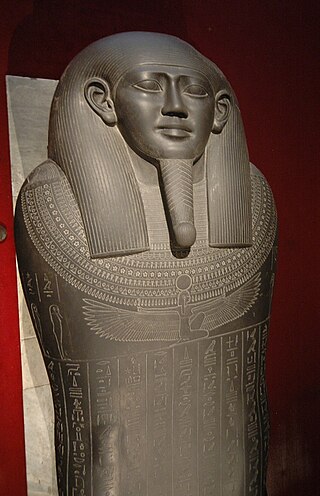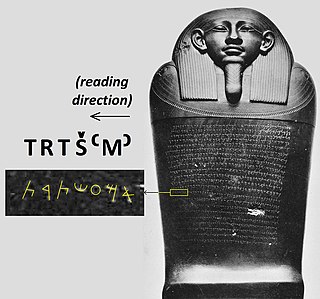
Eshmun was a Phoenician god of healing and the tutelary god of Sidon.

The sarcophagus ofEshmunazar II is a 6th-century BC sarcophagus unearthed in 1855 in the grounds of an ancient necropolis southeast of the city of Sidon, in modern-day Lebanon, that contained the body of Eshmunazar II, Phoenician King of Sidon. One of only three Ancient Egyptian sarcophagi found outside Egypt, with the other two belonging to Eshmunazar's parents King Tabnit and Queen Amoashtart, it was likely carved in Egypt from local amphibolite, and captured as booty by the Sidonians during their participation in Cambyses II's conquest of Egypt in 525 BC. The sarcophagus has two sets of Phoenician inscriptions, one on its lid and a partial copy of it on the sarcophagus trough, around the curvature of the head. The lid inscription was of great significance upon its discovery as it was the first Phoenician language inscription to be discovered in Phoenicia proper, the most detailed Phoenician text ever found anywhere up to that point, and is today the second longest extant Phoenician inscription, after the Karatepe bilingual.

The history of ancient Lebanon traces the course of events related to the geographic area in the Eastern Mediterranean of what is now known as Lebanon from the beginning of antiquity to the beginning of Arab rule.

The Temple of Eshmun is an ancient place of worship dedicated to Eshmun, the Phoenician god of healing. It is located near the Awali river, 2 kilometres (1.2 mi) northeast of Sidon in southwestern Lebanon. The site was occupied from the 7th century BC to the 8th century AD, suggesting an integrated relationship with the nearby city of Sidon. Although originally constructed by Sidonian king Eshmunazar II in the Achaemenid era to celebrate the city's recovered wealth and stature, the temple complex was greatly expanded by Bodashtart, Yatonmilk and later monarchs. Because the continued expansion spanned many centuries of alternating independence and foreign hegemony, the sanctuary features a wealth of different architectural and decorative styles and influences.

Eshmunazar II was the Phoenician king of Sidon. He was the grandson of Eshmunazar I, and a vassal king of the Persian Achaemenid Empire. He reigned after his father Tabnit I and died at the premature age of 14, and was succeeded by his cousin Bodashtart. The king is known from his sarcophagus, which features two Phoenician inscriptions and is currently housed in the Louvre Museum.

Bodashtart was a Phoenician ruler, who reigned as King of Sidon, the grandson of King Eshmunazar I, and a vassal of the Achaemenid Empire. He succeeded his cousin Eshmunazar II to the throne of Sidon, and scholars believe that he was succeeded by his son and proclaimed heir Yatonmilk.

Tabnit was the Phoenician King of Sidon c. 549–539 BC. He was the father of King Eshmunazar II.

Abdashtart I was a king of the Phoenician city-state of Sidon who reigned from 365 BC to 352 BC following the death of his father, Baalshillem II.

Tennes was a King of Sidon under the Achaemenid Empire, who ruled the Phoenician city-state of Sidon from, having been associated in power by his father since the 380s. It remains uncertain whether his known heir and successor, Tennes, was his son or some other close relative. His predecessor was Abdashtart I, the son of Baalshillem II

The first Achaemenid conquest of Egypt took place in 525 BCE, leading to the foundation of the Twenty-seventh Dynasty of Egypt, also known as the "First Egyptian Satrapy". Egypt thus became a province (satrapy) of the Achaemenid Persian Empire until 404 BCE while still maintaining Egyptian royalty customs and positions. The conquest was led by Cambyses II, the King of Persia, who defeated the Egyptians at the Battle of Pelusium, and crowned himself as Pharaoh of Egypt. Achaemenid rule was disestablished upon the rebellion and crowning of Amyrtaeus as Pharaoh. A second period of Achaemenid rule in Egypt occurred under the Thirty-first Dynasty of Egypt.
Yatonmilk was a Phoenician King of Sidon, and a vassal to the Achaemenid king of kings Darius I.

The Bodashtart inscriptions are a well-known group of between 22 and 24 Phoenician inscriptions from the 6th century BC referring to King Bodashtart.
The King of Sidon was the ruler of Sidon, an ancient Phoenician city in what is now Lebanon.

Josette Elayi-Escaich is a French antiquity historian, Phoenician and Near-Eastern history specialist, and honorary scholar at the French National Center for Scientific Research (CNRS). Elayi authored numerous archaeology and history works, and literary novels. She is well known to the French public through her novels and for her calls for reform and activism against the CNRS research policy bias. In 2007 Elayi was decorated Knight of the Legion of Honor by the French state.

The Baalshillem Temple Boy, or Ba'al Sillem Temple Boy, is a votive statue of a "temple boy" with a Phoenician inscription known as KAI 281. It was found along with a number of other votive statues of children near the canal in the Temple of Eshmun in 1963-64 by Maurice Dunand, and is currently in the National Museum of Beirut.
Eshmunazar I was a priest of Astarte and the Phoenician King of Sidon. He was the founder of his namesake dynasty, and a vassal king of the Achaemenid Empire. Eshmunazar participated in the Neo-Babylonian campaigns against Egypt under the command of either Nebuchadnezzar II or Nabonidus. The Sidonian king is mentioned in the funerary inscriptions engraved on the royal sarcophagi of his son Tabnit I and his grandson Eshmunazar II. The monarch's name is also attested in the dedicatory temple inscriptions of his other grandson, King Bodashtart.

Baalshillem I was a Phoenician King of Sidon, and a vassal of the Achaemenid Empire. He was succeeded by his son Abdamon to the throne of Sidon.

Amoashtart was a Phoenician queen of Sidon during the Persian period. She was the daughter of Eshmunazar I, and the wife of her brother, Tabnit. When Tabnit died, Amoashtart became co-regent to her then-infant son, Eshmunazar II, but after the boy died "in his fourteenth year", she was succeeded by her nephew Bodashtart, possibly in a palace coup. Modern historians have characterized her as an "energetic, responsible [woman], and endowed with immense political acumen, [who] exercised royal functions for many years".
Abdamon was a Phoenician King of Sidon, and a vassal of the Achaemenid Empire. He was succeeded by his son Baana to the throne of Sidon.
The Phoenician sanctuary of Kharayeb, is a historic temple in Southern Lebanon. It was surveyed during three archaeological missions. The first mission, led by then Director of Lebanon's Antiquities Maurice Chehab in 1946, revealed a Hellenistic period temple and thousands of clay figurines dating from the sixth to the first centuries BC. Subsequent excavations in 1969, carried out by Lebanese archaeologist Brahim Kaoukabani, and a more recent survey in 2009, funded by the Italian government, yielded significant discoveries regarding cultic practices and a detailed reconstruction of the sanctuary's architecture and development.
















